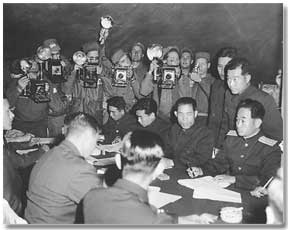|

(Click the picture for a larger view)
|
This official U.S. Navy photo is dated 23 October 1951. Many long months would pass before the
Armistice Agreement, whose text appears on this page of The Korean War Educator, would also be signed. Photo
courtesy of Bob Busch, St. Louis, MO.
Left to right (backs to camera) UNC Liaison Officer Col. James C. Murray, USMC; Senior UNC Liaison
Officer Col. Andrew J. Kinney, USAF; Lt. Col. Lee Soo Young, ROKA, UNC Liaison Officer, (with shoulderboards
across the table) Senior Communist Liaison Officer Col. Chang Chun San.
Although the American public doesn't hear much about it, the stalemate which began in Korea in July of 1951,
continued in 1952 and carried over into 1953. While peace talks lumbered on, the fighting continued, and
thousands of young American men died a needless death. From a very mobile war, the Korean War had by that time
transformed into a "static" war. Men died to hold ground that had already been gained, and to gain back ground
that had been lost to the enemy. Government leaders back in Washington, D.C. were reluctant to widen the war.
Their fellow countrymen were sick and tired of war, and moms and dads wanted their boys to come home. Through
negotiations, the major sticking point that was causing the stalemate in the peace talks--the prisoner of war
issue--was resolved. A cease fire would go into effect on July 27, 1953, and voluntary repatriation of prisoners
of war would begin under the watchful eye of the United Nations Command.
The full text of the Armistice Agreement can be read by clicking on the link below. In addition, the photo
link below will take our viewers to a number of Panmunjom-related photographs. The official US Navy photographs
shown on this page are from the private collection of retired St. Louis (Missouri) police lieutenant Robert J.
Busch. Bob served in the US Navy from 1944 until December of 1952, when he was discharged as a Chief Boatswain
Mate.
The Armistice Agreement
Armistice Agreement (PDF File)
Note: Due to the overwhelming size of this document and the formatting needed to make it
legible, it is available in PDF format rather than as a web page. This will facilitate uniform printing as
well.
|




